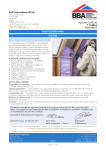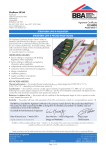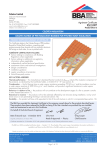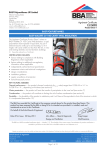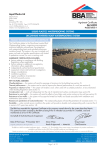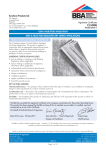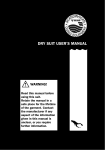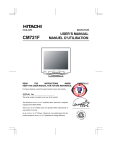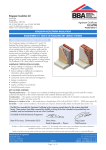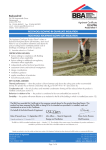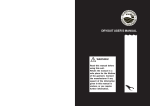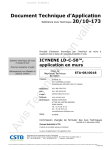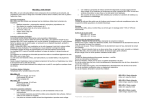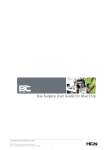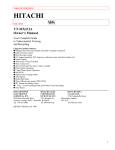Download Icynene Inc ICYNENE INSULATION ICYNENE LD-C
Transcript
APPROVAL INSPECTION TESTING CERTIFICATION Icynene Inc 6747 Campobello Road Mississauga Ontario L5N 2L7 Canada Tel: 00 1 905 363 4040 Fax: 00 1 905 363 0102 TECHNICAL APPROVALS FOR CONSTRUCTION Agrément Certificate 08/4598 e-mail: [email protected] website: www.icynene.com Product Sheet 1 ICYNENE INSULATION ICYNENE LD-C-50 PRODUCT SCOPE AND SUMMARY OF CERTIFICATE This Certificate relates to ICYNENE LD-C-50, a spray-applied, low-density open-cell, insulation foam, for use as an in-situ thermal insulation system for roofs, lofts, suspended timber ground floors and external walls of new and existing domestic or similar buildings. It is for use in timber frame wall cavities, between and under timber rafters, between and over ceiling joists, between timber floor joists where loading is not applied to the product and to the internal surface of masonry walls in combination with a dry-lining system. AGRÉMENT CERTIFICATION INCLUDES: • factors relating to compliance with Building Regulations where applicable • factors relating to additional non-regulatory information where applicable • independently verified technical specification • assessment criteria and technical investigations • design considerations • installation guidance • regular surveillance of production • formal three-yearly review. KEY FACTORS ASSESSED Practicability of installation — the product must only be installed by contractors trained and approved by the Certificate holder (see section 4). Thermal performance — when installed at an appropriate thickness, the product can enable elements to meet or improve on U values specified for notional and existing buildings (see section 5). Condensation risk — the product will contribute to minimising the risk of surface condensation and interstitial condensation driven by convection, but has a low µ value (between 2 and 5) and should be used with a vapour control layer (VCL) unless an assessment to BS 5250 : 2002 shows that it is not required (see section 6). Behaviour in relation to fire — building elements incorporating the product can be designed to meet the regulatory requirements (see section 7). Durability — the product is durable and will give a service life equivalent to that of the structure in which it is incorporated (see section 11). The BBA has awarded this Agrément Certificate to the company named above for the product described herein. This product has been assessed by the BBA as being fit for its intended use provided it is installed, used and maintained as set out in this Certificate. On behalf of the British Board of Agrément Date of Second issue: 9 September 2011 Sean Moriarty Greg Cooper Originally certificated on 14 November 2008 Head of Approvals — Physics Chief Executive The BBA is a UKAS accredited certification body — Number 113. The schedule of the current scope of accreditation for product certification is available in pdf format via the UKAS link on the BBA website at www.bbacerts.co.uk Readers are advised to check the validity and latest issue number of this Agrément Certificate by either referring to the BBA website or contacting the BBA direct. British Board of Agrément Bucknalls Lane Garston, Watford Herts WD25 9BA ©2011 Page 1 of 10 tel: 01923 665300 fax: 01923 665301 e-mail: [email protected] website: www.bbacerts.co.uk Regulations In the opinion of the BBA, ICYNENE LD-C-50, if used in accordance with the provisions of this Certificate, will meet or contribute to meeting the relevant requirements of the following Building Regulations: The Building Regulations 2010 (England and Wales) Requirement: C2(c) Resistance to moisture Comment: The risk of interstitial condensation must be assessed for each construction. The product can adequately limit the risk of surface condensation. See sections 6.1, 6.2 and 6.9 of this Certificate. Requirement: L1(a)(i) Conservation of fuel and power Comment: Requirement: Regulation 7 Materials and workmanship Comment: The product is an acceptable material. See section 11 and the Installation part of this Certificate. The product can contribute to meeting this Requirement. See sections 5.1 and 5.2 of this Certificate. The Building (Scotland) Regulations 2004 (as amended) Regulation: 8(1) Standard: 3.15 6.1(b) 6.2 7.1(a)(b) Statement of sustainability The product can contribute to meeting the relevant Requirements of Regulation 9, Standards 1 to 6 and therefore will contribute to a construction meeting at least a bronze level of sustainability as defined in this Standard. In addition the product can contribute to a construction meeting a higher level of sustainability as defined in this Standard, with reference to clauses 7.1.4(1)(2) Aspects 1(1)(2) and 2(1), 7.1.6(1)(2) Aspects 1(1)(2) and 2(1) and 7.1.7(1)(2) Aspect 1(1)(2). See section 5.1 of this Certificate. Comment: Regulation: Carbon dioxide emissions Building insulation envelope The product can contribute to a roof, floor or wall satisfying these Standards, with reference to clauses, or parts of, 6.1.1(1), 6.1.2(2), 6.1.3(1), 6.1.6(1), 6.2.1(1)(2), 6.2.3(1), 6.2.4(2), 6.2.5(2), 6.2.6(1), 6.2.7(1), 6.2.8(1)(2) to 6.2.11(1)(2), 6.2.12(2) and 6.2.13(1)(2). See sections 5.1 and 5.2 of this Certificate. Comment: Standard: Condensation The risk of interstitial condensation must be assessed for each construction. The product can adequately limit the risk of surface condensation, with reference to clauses 3.15.1(1)(2), 3.15.3(1)(2), 3.15.4(1)(2), 3.15.5(1)(2) and 3.15.7(1)(2). See sections 6.1, 6.2 and 6.10 of this Certificate. Comment: Standard: Standard: Fitness and durability of materials and workmanship The product can contribute to a construction satisfying this Regulation. See section 11 and the Installation part of this Certificate. Comment: 12 Building standards — conversions Comments made in relation to the product under Regulation 9, Standards 1 to 6 also apply to this Regulation, with reference to clause 0.12.1(1)(2) and Schedule 6(1)(2). Comment: (1) Technical Handbook (Domestic). (2) Technical Handbook (Non-Domestic). The Building Regulations (Northern Ireland) 2000 (as amended) Regulation: B2 Fitness of materials and workmanship Comment: Regulation: C5 Condensation The product is acceptable. See section 11 and the Installation part of this Certificate. The risk of interstitial condensation must be assessed for each construction. See sections 6.1 and 6.2 of this Certificate. Comment: Regulation: Regulation: Comment: F2(a)(i) F3(2) Conservation measures Target carbon dioxide Emissions Rate The product can contribute to meeting these Regulations. See sections 5.1 and 5.2 of this Certificate. Construction (Design and Management) Regulations 2007 Construction (Design and Management) Regulations (Northern Ireland) 2007 Information in this Certificate may assist the client, CDM co-ordinator, designer and contractors to address their obligations under these Regulations. See sections: 2 Delivery and site handling (2.3) and 13 Precautions (13.1 to 13.6) of this Certificate. Non-regulatory Information NHBC Standards 2011 NHBC accepts the use of ICYNENE LD-C-50, when installed and used in accordance with this Certificate, in relation to NHBC Standards, Chapter 5.2 Suspended ground floors, Chapter 6.1 External masonry walls, Chapter 6.2 External timber framed walls and Chapter 7.2 Pitched roofs. Page 2 of 10 Technical Specification 1 Description 1.1 ICYNENE LD-C-50(1) is a spray-applied, low-density (typically 7 kg·m–3), open-cell, 100% water blown soft insulation foam for use in timber-frame stud walling, pitched roofs, lofts and suspended timber ground floors, and for internal work on new and existing masonry walls. 1.2 The foam is prepared from two liquid components, Base Seal(1) (isocyanate) and Gold Seal(1) (polyol), which are mixed within the nozzle of the spray gun during the application process. The product is applied in thicknesses up to 300 mm, and fully cures within 10 seconds 1.3 Quality control arrangements on site include checks for density and appearance. (1) ICYNENE LD-C-50, Base Seal and Gold Seal are registered trademarks of Icynene Inc. 2 Delivery and site handling 2.1 The two components, Base Seal and Gold Seal, are delivered to site in drums of up to 250 kg net capacity bearing the product name, batch number and the BBA identification mark incorporating the number of this Certificate. 2.2 Drums should be stored in a well-ventilated area, away from possible ignition sources. The drums must be protected from frost and conditioned at temperatures of between 15°C and 32°C prior to use. 2.3 The isocyanate and polyol are classified as ‘harmful’ and ‘irritant’ respectively under The Chemicals (Hazard Information and Packaging for Supply) Regulations 2009 (CHIP4)/Classification, Labelling and Packaging of Substances and Mixtures (CLP Regulation) 2009, and the packaging bears the appropriate hazard warning labels. When cured, ICYNENE LD-C-50 does not constitute a hazard. Assessment and Technical Investigations The following is a summary of the assessment and technical investigations carried out on ICYNENE LD-C-50. Design Considerations 3 Use 3.1 ICYNENE LD-C-50 is satisfactory for use in reducing the thermal transmittance (U value) and contributing to the airtightness of walls, roofs, lofts and floors of dwellings or buildings of similar occupancy. 3.2 The product can be used: • between or, between and under timber rafters, where the purlin and ridge may be steel (including open web types) • between or, between and over ceiling joists in a non-habitable roof (loft space) • between joists in suspended timber ground floors provided this application is non-loadbearing • between the studs of conventional timber-frame external wall constructions • between the void created by timber battens on the internal face of external masonry(1) walls, and lined with plasterboard. (1) Masonry constructions include clay and calcium silicate bricks, concrete blocks, and natural and reconstituted stone blocks. It is essential that such walls are constructed having regard to the local wind-driven rain index. 3.3 In all applications the product must be covered by suitable internal lining boards, except when used in the loft or suspended timber floor applications (see also section 6.4). 3.4 New constructions must be designed in accordance with the relevant recommendations of: • BS 5250 : 2002 • BS 5534 : 2003 • BS 5628-3 : 2005 • BS 8000-3 : 2001 • BS 8103-3 : 1996 • BS EN 1995-1-1 : 2004 • BS EN 1996-1-1 : 2005 • BS EN 1996-1-2 : 2005 • BS EN 1996-2 : 2006 • BS EN 1996-3 : 2006. 3.5 Existing constructions must be in a good state of repair with no evidence of rain penetration or damp. Defects must be made good prior to installation. 3.6 If present, mould or fungal growth must be treated prior to the application of the product. 3.7 The product must not come into direct contact with flue pipes, chimneys or other heat producing appliances (see section 8). 3.8 It is essential that construction elements are designed and constructed to incorporate normal precautions against moisture ingress before the application of the product. 3.9 The product forms a strong bond with clean, dry substrates. This should be taken into account when specifying the product or anticipating future alterations. Page 3 of 10 3.10 To satisfy the requirements of NHBC, a VCL of a type specified in their Standards must be applied behind the plasterboard lining in roof and wall applications, and the product must only be applied to a roof construction incorporating a breathable roof tile underlay. Pitched roofs, including tiled or slated to BS 5534 : 2003 3.11 The product can be applied directly to bitumen felt, breathable roof tile underlays or timber sarking boards. Counter battens must be used below the tile battens when applying the product to breathable roof tile underlays. 3.12 Care must be taken to ensure the integrity of the roof tile underlay drape, when spraying the product. 3.13 Pitched roofs are defined for the purpose of this Certificate as those roofs having a pitch in excess of 15°. External masonry walls (insulated dry lining) 3.14 Insulated dry lining systems require careful detailing during installation around doors and windows to achieve a satisfactory surface for finishing. In addition, every attempt should be made to minimise the risk of thermal bridging at reveals and where heavy separating walls are attached to the external wall. New work must be designed to accommodate the thickness of the dry lining, particularly at reveals, heads, sills and in relation to ceiling height. Where the dimensions of fixtures are critical (eg bathrooms) these should be checked before installation. 3.15 It is recommended that services which penetrate the dry lining, eg, light switches, power outlets, are kept to a minimum to limit damage to vapour checks. External walls (timber-frame) 3.16 Constructions incorporating a masonry outer leaf (such as masonry units and natural stone blocks) should be in accordance with BS 5628-3 : 2005 and BS 8000-3 : 2001, BS EN 1996-1-1 : 2005, BS EN 1996-1-2 : 2005, BS EN 1996-2 : 2006, BS EN 1996-3 : 2006. The designed residual cavity width should be 50 mm wide. 3.17 It is recommended that services which penetrate the dry lining, eg, light switches, power outlets, are kept to a minimum to limit damage to vapour checks. In addition, any penetrations should be either enclosed in plasterboard or stone mineral wool or suitably tested proprietary fire-rated systems in order to preserve the fire resistance of the wall. 3.18 Installation must not be carried out until the moisture content of the timber frame is less than 20%. 4 Practicability of installation The product must only be installed by contractors trained and approved by the Certificate holder in accordance with the Certificate holder’s Installation Manual (see also section 12). 5 Thermal performance General 5.1 Calculations of the thermal transmittance (U value) should be carried out in accordance with BS EN ISO 6946 : 2007 and BRE Report (BR 443 : 2006) Conventions for U-value calculations using the ‘typical’ thermal conductivity ( value) for the product of 0.039 W·m–1·K–1. When considering insulation requirements, designers should refer to the detailed guidance contained in the documents supporting the national Building Regulations. The U values shown in Tables 1 and 2 indicate that the product can contribute to a wall achieving typical design U values referred to in those supporting documents. Table 1 U values (1) for pitched and flat roofs, lofts and timber frame walls Element type Timber dimensions (mm) ICYNENE LD-C-50 (mm) and location with respect to rafter/joist/batten or stud Existing sloping roof Rafters = 50 x 150 at 400 centres 70(2) 90(2) 150 150 0.20 0.18 Rafters = 47 x 200 at 600 centres 20(2) 40(2) 60(2) 120(2) 200 200 200 200 0.20 0.18 0.16 0.13 Loft Joists = 50 x 100 at 400 centres 100(3) 120(3) 150(3) 200(3) 100 100 100 100 0.20 0.18 0.16 0.13 Timber frame wall Studs = 38 x 140 at 600 centres 10(4) 30(4) 140 140 140 0.30 0.28 0.25 Studs = 38 x 200 at 600 centres 30(4) 200 0.19 inside New sloping roof Timber frame wall between (1) Plasterboard taken as 12.5 mm at 0.25 W·m–1·k–1 and all timber % taken from BRE Report (BR 443 : 2006). (2) 47 mm cross battens at 600 mm centres. (3) ICYNENE LD-C-50 above ceiling joists. (4) 47 mm counter battens at 600 mm centres. Page 4 of 10 U value (W·m–2·K–1) Table 2 Typical U values at 150 mm and 200 mm insulation thickness — suspended timber floors P/A (perimeter/area) U value 150 mm ICYNENE LD-C-50 (W·m–2·K–1) U value 200 mm ICYNENE LD-C-50 (W·m–2·K–1) 0.2 0.18 0.15 0.4 0.21 0.17 0.6 0.22 0.18 0.8 0.23 0.19 1.0 0.24 0.19 Note: Assuming construction of floor (external to internal): • foam insulation (89%)/timber joists (11%) • chipboard – 22 mm. 5.2 The product can maintain, or contribute to maintaining, continuity of thermal insulation at junctions between elements and openings. Default psi values in BRE Information Paper IP1/06 Assessing the effects of thermal bridging at junctions and around openings, Table 3 may be used in carbon emission calculations in Scotland and Northern Ireland. Detailed guidance for other junctions and on limiting heat loss by air infiltration can be found in: England and Wales — Approved Documents to Part L and for new thermal elements to existing buildings, Accredited Construction Details (version 1.0). See also SAP 2009 Appendix K and the iSBEM User Manual for new-build Scotland — Accredited Construction Details (Scotland) Northern Ireland — Accredited Construction Details (version 1.0). 6 Condensation risk Interstitial condensation 6.1 Roofs, floors and walls should be designed and constructed in accordance with the relevant parts of BS 5250 : 2002 and Annex D, and BRE Report (BR 262 : 2002) Thermal insulation: avoiding risks for roofs and floors in England and Wales, including a well-sealed ceiling for the roof applications, or BS EN 15026 : 2007, using a µ value between 2 and 5 for the product. A VCL is required on the warm side of the insulation unless an assessment to BS 5250 : 2002 using the least favourable µ value indicates that it is not necessary for a particular construction. 6.2 Care should be taken to provide adequate ventilation, particularly in rooms expected to experience high humidities, and to ensure the integrity of VCL’s (where installed) and linings, against vapour ingress. 6.3 It is essential that roof design, construction and maintenance not only limits opportunities for vapour migration by diffusion but also by convection through gaps, cracks and laps in air and or VCL’s and through penetrations. This is particularly important when the design includes layers of high resistance to vapour diffusion on both sides of the insulation layer. Pitched roof application with bitumen felt or sarking board 6.4 Dynamic simulations to BS EN 15026 : 2007 indicate that VCL with a resistance of 250 MN·s·g–1 (with sealed laps) is acceptable in roofs with no penetrations. The suitability of other constructions may be assessed by using an appropriate dynamic modelling package, see section 16.3. Loft application 6.5 Insulation material placed at ceiling level will considerably reduce the temperature of an unheated roof structure and, if moist air passes into the roof space, condensation on cold surfaces is likely to be enhanced. Roof structures incorporating the insulation at ceiling level must have provision for adequate permanent ventilation of the space above the insulation to minimise the formation of condensation in the roof space. 6.6 Permanent ventilation of the roof structure should be provided by continuous openings or regularly spaced vents of equivalent area situated along two opposite sides of the roof at eaves level. The size and position of ventilation openings for pitched roofs greater or less than 15°, roofs with spans exceeding 10 m, and mono-pitched roofs, should be in accordance with Clause 8.4 (in particular 8.4.2.2 ) of BS 5250 : 2002. Further information and guidance is given in BRE Report (BR 262 : 2002). 6.7 Ventilation openings should be arranged to prevent the ingress of rain, snow, birds and small mammals and the risk of subsequent blockage by other building operations. Masonry external walls (insulated dry lining) 6.8 The risk of summer condensation on the VCL must be considered for solid masonry walls, orientated from ESE through south to WSW, in accordance with section 3.10 of BRE Report (BR 262 : 2002). Page 5 of 10 Surface condensation 6.9 Roofs, floors and walls will adequately limit the risk of surface condensation where the thermal transmittance (U value) does not exceed 0.7 W·m–2·K–1 for walls and floors and 0.35 W·m–2·K–1 for roofs at any point and the junctions are designed in accordance with Limiting thermal bridging and air leakage : Robust construction details for dwellings and similar buildings TSO 2002, BRE Information Paper IP1/06 or section 5.2 of this Certificate. 6.10 Roofs, floors and walls designed to BS 5250 : 2002, Section 8, will adequately limit the risk of surface condensation where the thermal transmittance (U value) does not exceed 1.2 W·m–2·K–1 at any point. Guidance may by obtained from, BRE Report (BR 262 : 2002) and section 5.2 of this Certificate. 7 Behaviour in relation to fire 7.1 The product is combustible and must be protected from naked flames and other ignition sources during and after installation. 7.2 The product achieved a rating of B-s1, d0 when tested to BS EN 13823 : 2002 in a construction consisting of timber boxes 100 mm deep, filled with spray-applied ICYNENE LD-C-50 foam and faced with 12 mm thick, gypsum plasterboard Class A2 and density 800 ± 100 kg·m–3. 7.3 Once installed, except for the unoccupied loft application and the suspended timber floor application, the product must be contained by a suitable lining board, eg 12.5 mm plasterboard, with joints fully sealed and supported by rafters, battens or studs. Therefore, the product will not contribute to the development stages of a fire. 7.4 Elements must incorporate cavity barriers at edges, around openings and at junctions with fire-resisting elements, and the maximum dimensions of any cavity in any direction must not exceed 10 m in accordance with the relevant provisions of the national Building Regulations. The design and installation of cavity barriers must take into account any anticipated differential movement. External timber frame walls 7.5 The product can be added to the void between studwork, or used as a substitute for glass mineral wool or combustible insulation material, in any loadbearing, timber-framed inner leaf to a double leaf wall system providing that: • the outer leaf is masonry, and • the existing inner leaf system has been shown to satisfy the loadbearing capacity performance criterion of BS 476-21 : 1987 or BS EN 1365-1 : 1999 for the required fire resistance period. 7.6 The suitability of constructions other than those described in section 7.5 should be demonstrated by an appropriate test or assessment. Roofs 7.7 The use of the product in a tiled pitched roof will not affect it’s external rating when evaluated by assessment or test to BS 476-3 : 2004. 8 Proximity of flues and appliances 8.1 When installing the product in close proximity to certain flue pipes and/or heat producing appliances, the relevant provisions of the national Building Regulations are applicable: England and Wales — Approved Document J Scotland — Mandatory Standard 3.19, with reference to clauses 3.19.1(1)(2) to 3.19.9(1)(2) (1) Technical Handbook (Domestic). (2) Technical Handbook (Non-Domestic). Northern Ireland — Technical Booklet L. 8.2 The product must not be installed within 50 mm of heat emitting devices, where the temperature is in excess of 93°C. 9 Materials in contact — wiring installations 9.1 The product is compatible with materials in contact. 9.2 De-rating of electric cables should be considered in areas where the product restricts the flow of air. The use of suitable conduit or trunking is recommended. 9.3 Where recessed lighting is used, provision should be made to prevent the fitting overheating, or ventilated fittings must used. 10 Maintenance The product, once installed does not require any regular maintenance and has suitable durability (see section 11), provided the waterproof layers are inspected and maintained at regular intervals. 11 Durability The durability of the product is satisfactory and will have a life equivalent to that of the structure in which it is incorporated. Page 6 of 10 Installation 12 Approved installers The Certificate holder operates an Approved Installer Scheme for this product, under which the installers are approved, registered and regularly reviewed by the Certificate holder to demonstrate that they are competent to carry out installation of the product in accordance with this Certificate. Details of Approved Installers are available from the Certificate holder. Approved Installers are responsible for each installation of the product that they undertake. 13 Precautions 13.1 To comply with the requirements of Section 4 of the Health and Safety at Work Act 1974, it is essential that there is an exchange of information between the client and the installer before spray operations commence on any site. Existing health hazards and those brought into the premises by the installer should be discussed and measures agreed to deal with them effectively. 13.2 The process for the installation of the product may produce a build-up of harmful vapours. Installers must wear full personal protection equipment when working with the product, including full-face fresh-air supplied respirators, protective clothing and gloves. Other trades and personnel must be kept at least four metres away from the applicator while spraying is taking place. The requirements of the Icynene Installer Training Manual must be followed at all times. 13.3 Vapours given off by certain components, ie 4,4’ diphenylmethane diisocyanate (MDI), are generally heavier than air and will tend to move to lower parts of the building. These parts should be suitably ventilated. 13.4 If vapour levels need to be measured, methods should be those recommended by the Health and Safety Executive. Certain applications, ie confined roofs, require the use of extractor fans as recommended by the Certificate holder. 13.5 Care should be taken to minimise the degree of overspray generated whilst spraying. This is in the form of a fine mist of polyicynene particles that can travel considerable distances and will adhere strongly to surfaces they land on. 13.6 To prevent the product from entering the occupied space, the loft hatch/cover must be kept closed during the spraying process. Protective covers must be placed over water tanks to prevent contamination and blockage during application, and should not be removed until sufficient time has elapsed for potentially harmful vapours to be ventilated from the roof space. 14 Procedure General 14.1 Building elements to be insulated must be assessed for suitability and any necessary repairs carried out. Elements must be weather tight before the application of the product. The positioning and access to services should also be considered. 14.2 Access boards and lighting should be positioned in the roof void. 14.3 The product should be stored, handled and applied in accordance with the Certificate holder’s instructions and this Certificate. 14.4 The product should be spray applied to clean and dry substrates and built up in layers of up to 300 mm in thickness. 14.5 The product contains no organic blowing agents. The polyol component contains water which vaporises due to the exothermic reaction to create the cell structure. The resulting solid foam is fully-reacted (cured) in seconds. 14.6 Once cured, if required the product is trimmed flat using a saw and covered with lining board. 14.7 Where there is no provision made for ventilation of the space, care should be taken to ensure that ingress of moisture vapour from the dwelling space below is restricted. Pitched roof application — between rafters 14.8 The product is sprayed into the cavity formed by the rafters, or rafters and counter battens. When cured, the excess foam is trimmed flush with the rafters and the lining board installed with a VCL with lapped and sealed joints. 14.9 When spraying to breathable roof tile underlays, counter battens must be used below tile battens. Pitched roof application — between and below rafters 14.10 The foam is applied by spray to the depth of the rafters as in section 14.8 or 14.9. Cross-battens are then mechanically fixed to the rafters. The battens must be of sufficient width and spacing (up to 600 mm) to provide adequate support to which the plasterboard can be mechanically fixed. When cured, if fully-filled, the excess foam is trimmed flush with the studs and the lining board installed with a VCL with lapped and sealed joints. Loft application 14.11 All removable obstructions should first be cleared from the loft space and any holes in the ceiling, such as around pipes, should be sealed. Water tanks should be covered and any sources of moisture, eg vent pipes for central heating, should be arranged to avoid water vapour entering the loft space. Page 7 of 10 14.12 To reduce the risk of frost damage due to ceiling insulation, the pipes and tank in the loft space should be lagged before installing the product. The area directly below cold water tanks when resting at joist level must not be insulated to avoid the risk of the stored water freezing in cold weather. 14.13 During installation it is essential that all ventilation points, for example eaves gaps and air bricks at gable ends, are kept clear of insulant so that the air flow is maintained. Suitable proprietary eaves ventilators must be used (see also section 6.7). 14.14 In new and existing constructions the product should be installed, after tiling or slating is completed, from inside the roof space. 14.15 The product is applied to plasterboard, between ceiling joists. The product may also be applied over joists. Timber frame walls 14.16 The product is sprayed into the cavity formed by the studs and the sheathing board. When cured, if the cavity is fully-filled, the excess foam is trimmed flush with the studs and the lining board installed with a VCL with lapped and sealed joints. Masonry external walls 14.17 Installation should be in accordance with good dry lining practice and the relevant parts of the Certificate holder’s literature. 14.18 Before applying the product, sufficient time must be allowed for damp-proofing treatments, where applied, to dry out the wall (see also, BS 6576 : 2005 for dry lining in conjunction with a chemical damp proof course application). 14.19 This system may be used on any stable, dry wall capable of taking the fixings for the timber battens. 14.20 Wallpaper, skirting, picture rails, gloss paint and projecting window boards are removed. 14.21 Pre-treated horizontal timber battens of sufficient thickness are mechanically fixed to the wall substrate at maximum 600 mm centres. Vertical battens are then fitted, with additional battens used around openings and to support heavy horizontal items. 14.22 The product is sprayed into the cavity formed by the battens. When cured, if the cavity is fully-filled, the excess foam is trimmed flush with the battens and the lining board installed with a VCL with lapped and sealed joints. Suspended timber ground floors 14.23 A barrier (such as thin plywood or a vapour permeable membrane) must be fixed to the underside of the joists to contain the foam. The product is then sprayed from above into the cavity formed by the barrier and the joists. When cured, the excess foam is trimmed flush with the joists and the flooring board installed. 14.24 An air gap of at least 150 mm must be left between the joists and the ground to allow for sub-floor ventilation. Technical Investigations 15 Tests Tests were carried out by the BBA on ICYNENE LD-C-50 and the results assessed to determine: • adhesion to timber substrate after heat ageing and water immersion • density • water vapour resistivity • dimensional stability • thermal conductivity. 16 Investigations 16.1 An assessment was made of independent data relating to: • thermal conductivity • density • fire properties • dimensional stability. 16.2 A visit was made to a site in progress to assess the methods of application and the material’s behaviour in use. 16.3 A series of dynamic computer simulations to BS EN 15026 : 2007 were carried out on a range of roof constructions to assess the risk of interstitial condensation. The simulations included building humidity Class 4, meteorological data for solar irradiation (direct and indirect) and rainfall for standard reference years, material moisture storage functions, porosity, specific heat capacity and long term projections of material moisture contents. 16.4 An opinion was sought from a UKAS-accredited fire authority concerning the fire resistance of the product when used between studs in a conventional timber-frame construction. 16.5 The manufacturing process and quality control procedures were examined. Page 8 of 10 Bibliography BS 476-3 : 2004 Fire tests on building materials and structures — Classification and method of test for external fire exposure to roofs BS 476-21 : 1987 Fire tests on building materials and structures — Methods for determination of the fire resistance of loadbearing elements of construction BS 5250 : 2002 Code of practice for control of condensation in buildings BS 5534 : 2003 Code of practice for slating and tiling (including shingles) BS 5628-3 : 2005 Code of practice for the use of masonry — Materials and components, design and workmanship BS 6576 : 2005 Code of practice for diagnosis of rising damp in walls of buildings and installation of chemical damp-proof courses BS 8000-3 : 2001 Workmanship on building sites — Code of practice for masonry BS 8103-3 : 1996 Structural design of low-rise buildings — Code of practice for timber floors and roofs for housing BS EN 1365-1 : 1999 Fire resistance tests for loadbearing elements — Walls BS EN 1995-1-1 : 2004 Eurocode 5 : Design of timber structures — General — Common rules and rules for buildings BS EN 1996-1-1 : 2005 Eurocode 6 : Design of masonry structures — General rules for reinforced and unreinforced masonry structures BS EN 1996-1-2 : 2005 Eurocode 6 : Design of masonry structures — General rules — Structural fire design BS EN 1996-2 : 2006 Eurocode 6 : Design of masonry structures — Design considerations, selection of materials and execution of masonry BS EN 1996-3 : 2006 Eurocode 6 : Design of masonry structures : Simplified calculation methods for unreinforced masonry structures BS EN 13823 : 2002 Reaction to fire tests for building products — Building products excluding floorings exposed to the thermal attack by a single burning item BS EN 15026 : 2007 Hygrothermal performance of building components and building elements — Assessment of moisture transfer by numerical simulation BS EN ISO 6946 : 2007 Building components and building elements — Thermal resistance and thermal transmittance — Calculation method Page 9 of 10 Conditions of Certification 17 Conditions 17.1 This Certificate: • relates only to the product/system that is named and described on the front page • is issued only to the company, firm, organisation or person named on the front page — no other company, firm, organisation or person may hold or claim that this Certificate has been issued to them • is valid only within the UK • has to be read, considered and used as a whole document — it may be misleading and will be incomplete to be selective • is copyright of the BBA • is subject to English Law. 17.2 Publications, documents, specifications, legislation, regulations, standards and the like referenced in this Certificate are those that were current and/or deemed relevant by the BBA at the date of issue or reissue of this Certificate. 17.3 This Certificate will remain valid for an unlimited period provided that the product/system and its manufacture and/or fabrication, including all related and relevant parts and processes thereof: • are maintained at or above the levels which have been assessed and found to be satisfactory by the BBA • continue to be checked as and when deemed appropriate by the BBA under arrangements that it will determine • are reviewed by the BBA as and when it considers appropriate. 17.4 The BBA has used due skill, care and diligence in preparing this Certificate, but no warranty is provided. 17.5 In issuing this Certificate, the BBA is not responsible and is excluded from any liability to any company, firm, organisation or person, for any matters arising directly or indirectly from: • the presence or absence of any patent, intellectual property or similar rights subsisting in the product/system or any other product/system • the right of the Certificate holder to manufacture, supply, install, maintain or market the product/system • individual installations of the product/system, including their nature, design, methods, performance, workmanship and maintenance • any works and constructions in which the product/system is installed, including their nature, design, methods, performance, workmanship and maintenance • any loss or damage, including personal injury, howsoever caused by the product/system, including its manufacture, supply, installation, use, maintenance and removal. 17.6 Any information relating to the manufacture, supply, installation, use, maintenance and removal of this product/ system which is contained or referred to in this Certificate is the minimum required to be met when the product/system is manufactured, supplied, installed, used, maintained and removed. It does not purport in any way to restate the requirements of the Health and Safety at Work etc. Act 1974, or of any other statutory, common law or other duty which may exist at the date of issue or reissue of this Certificate; nor is conformity with such information to be taken as satisfying the requirements of the 1974 Act or of any statutory, common law or other duty of care. British Board of Agrément Bucknalls Lane Garston, Watford Herts WD25 9BA ©2011 Page 10 of 10 tel: 01923 665300 fax: 01923 665301 e-mail: [email protected] website: www.bbacerts.co.uk










